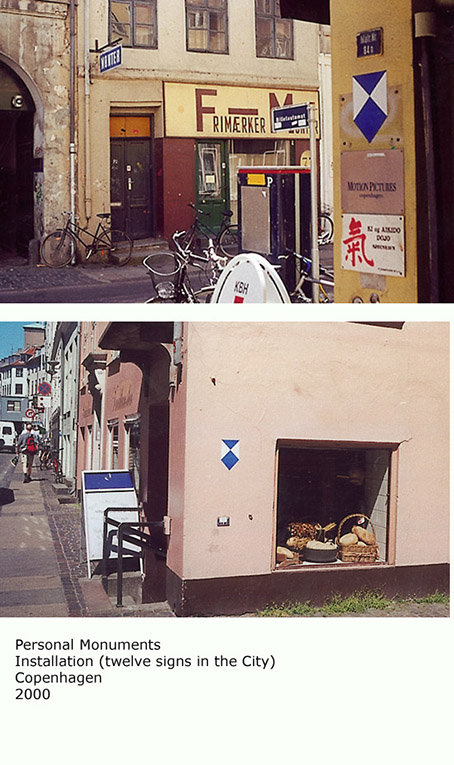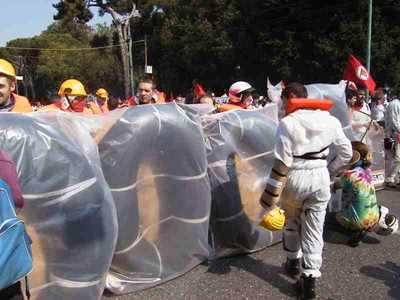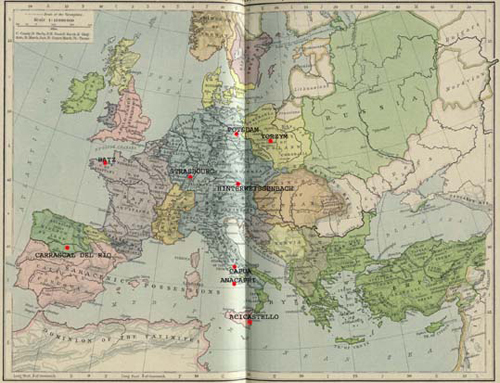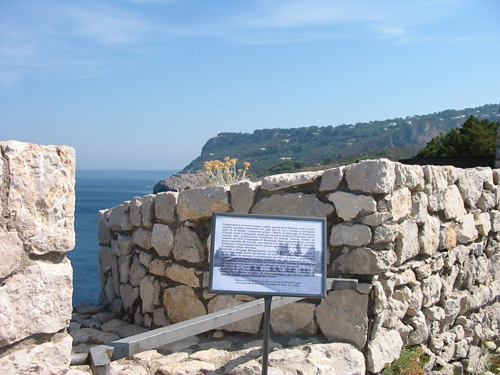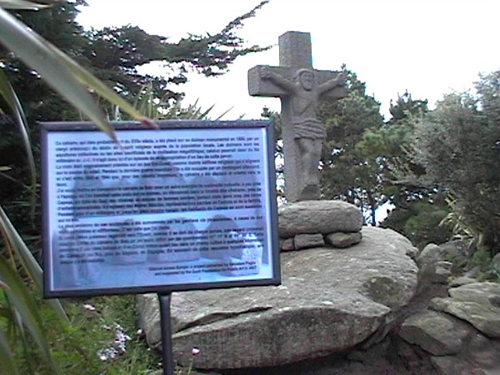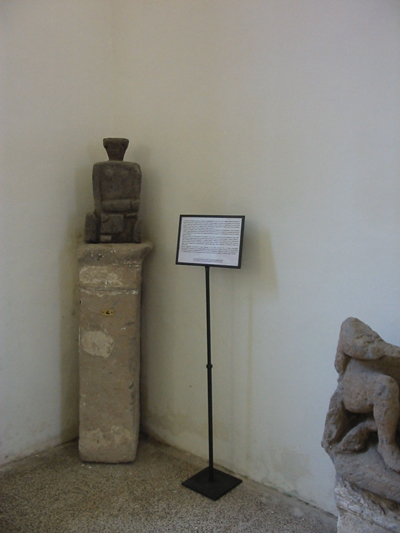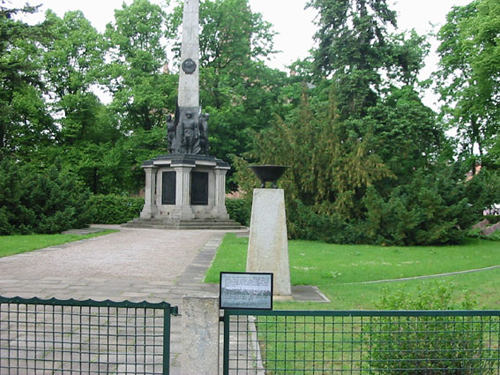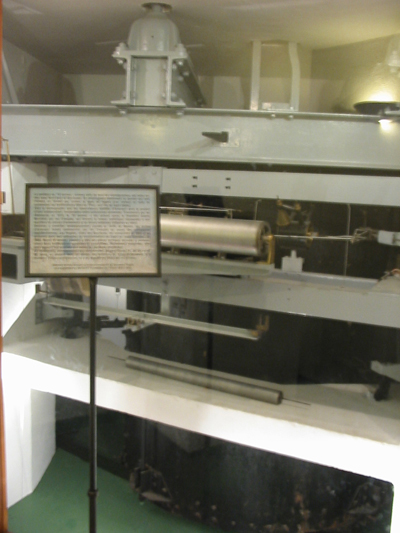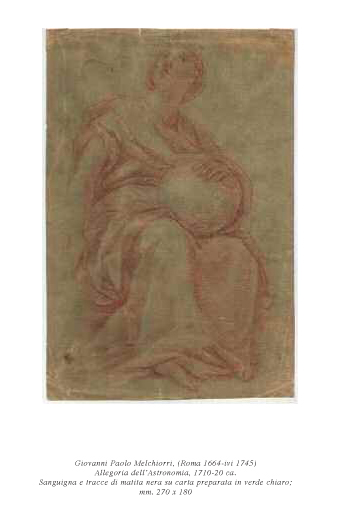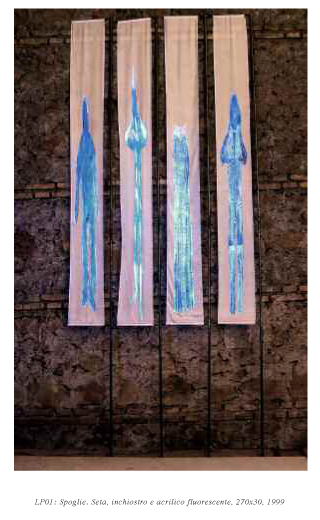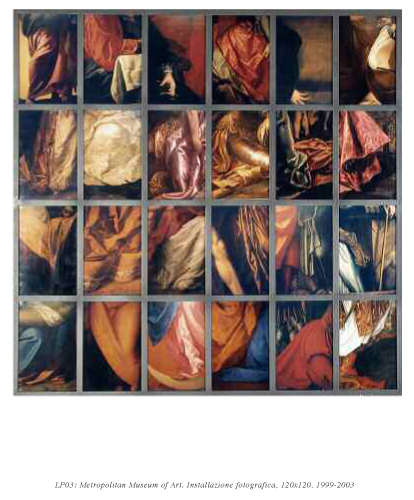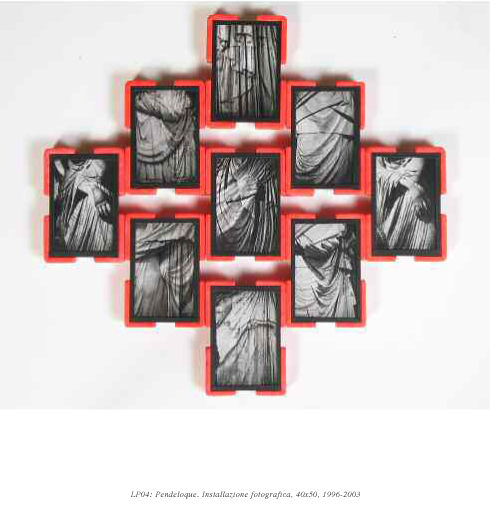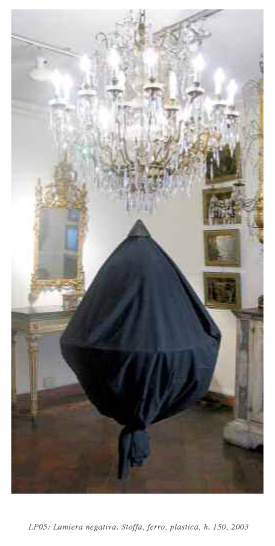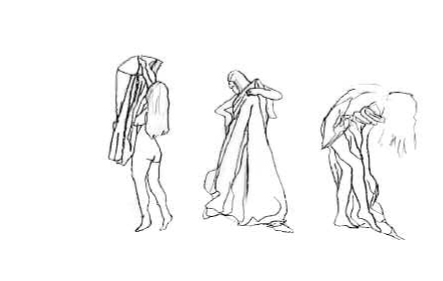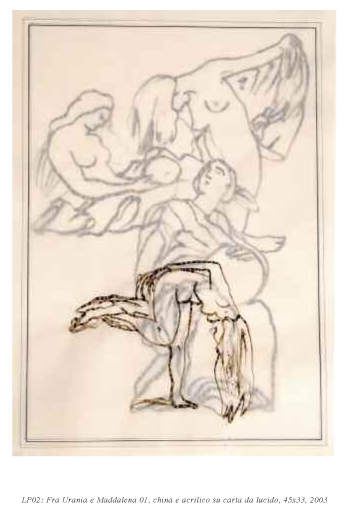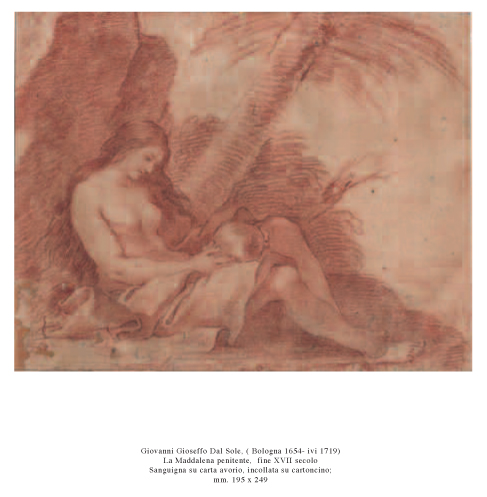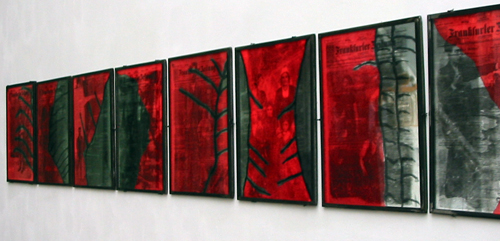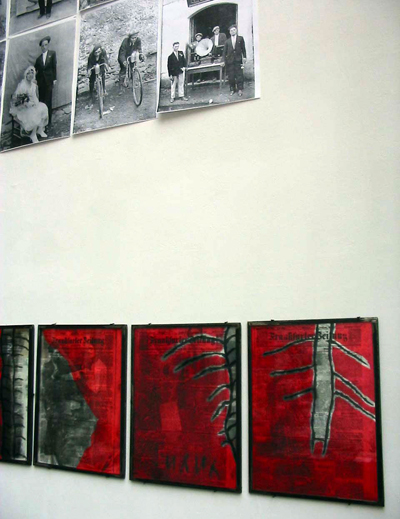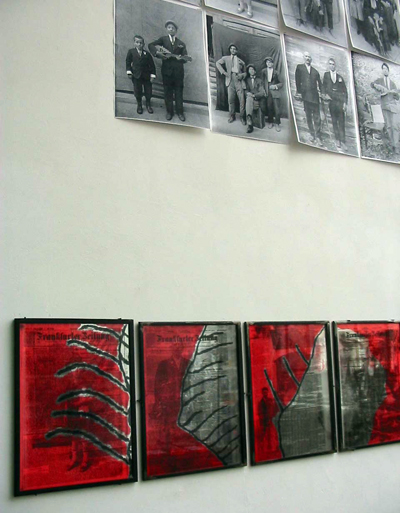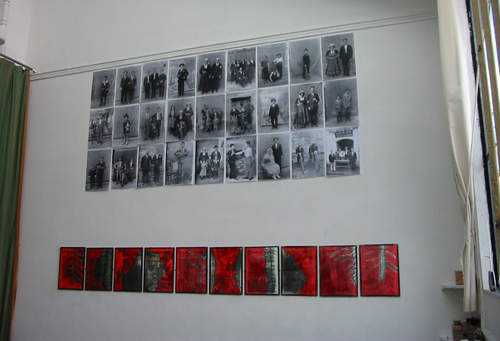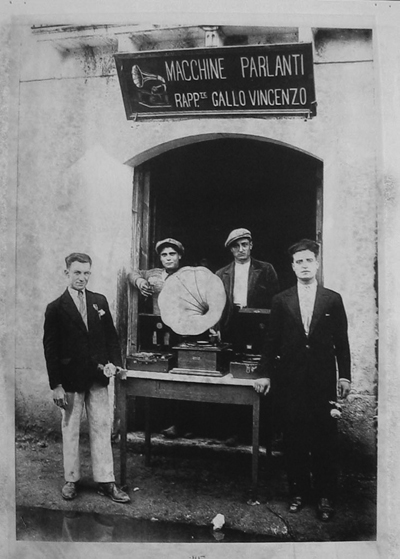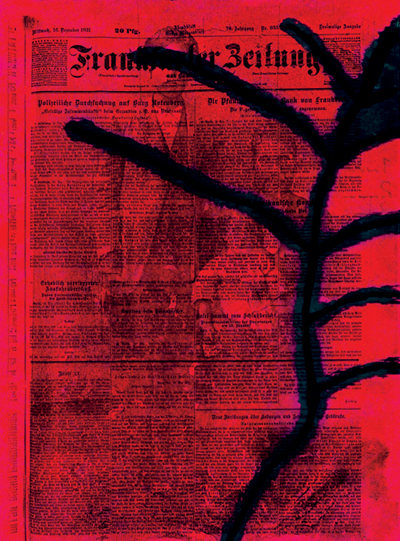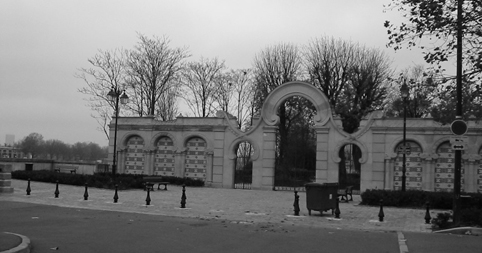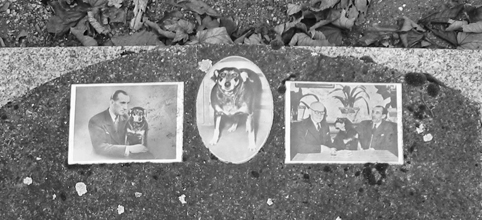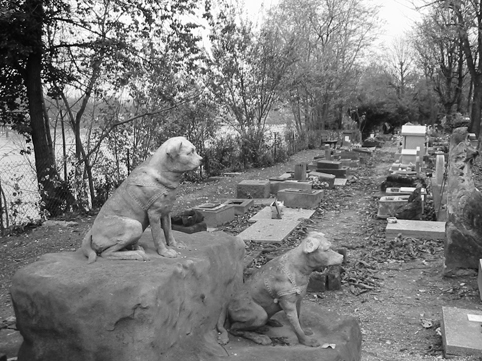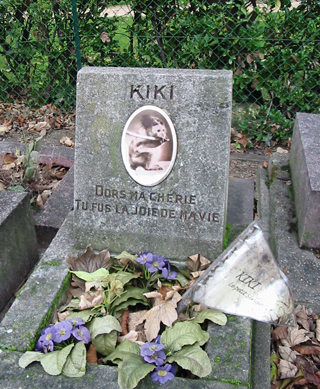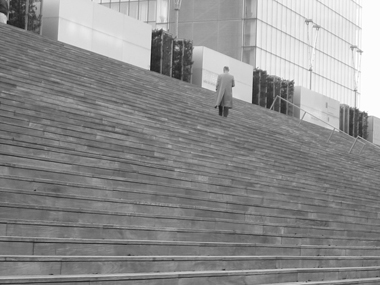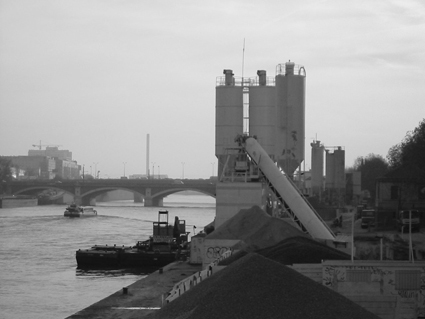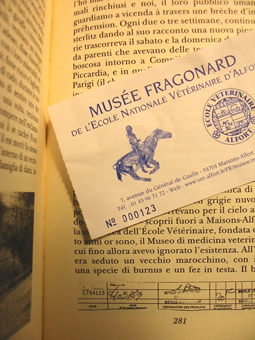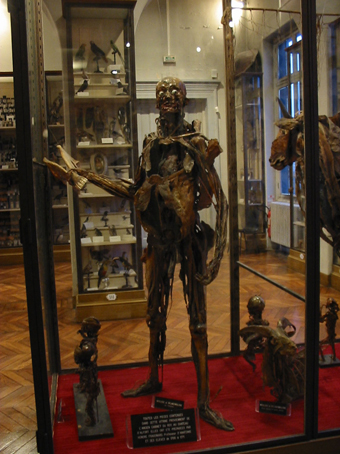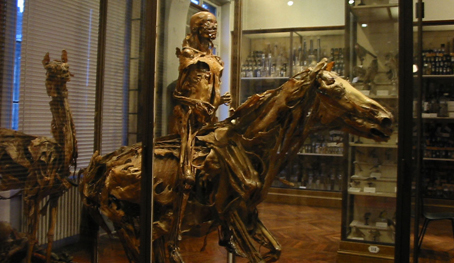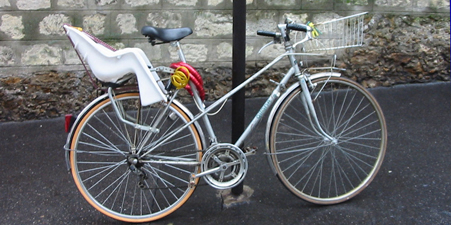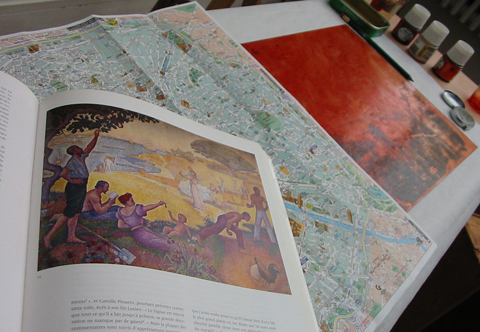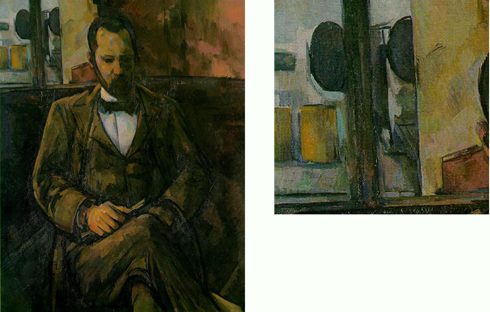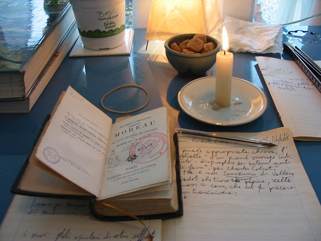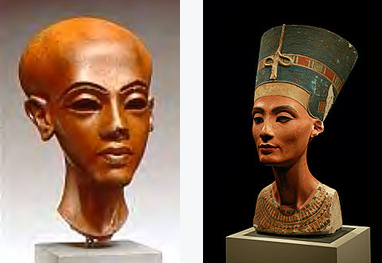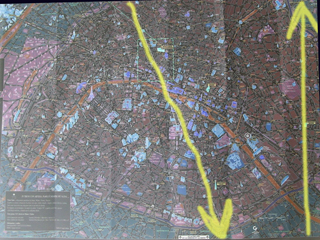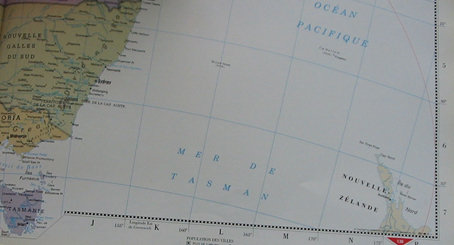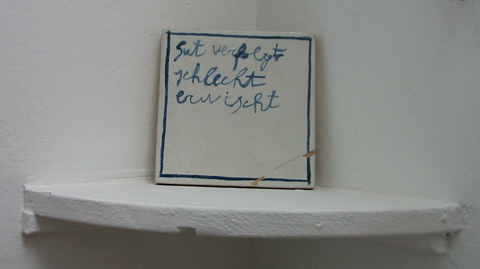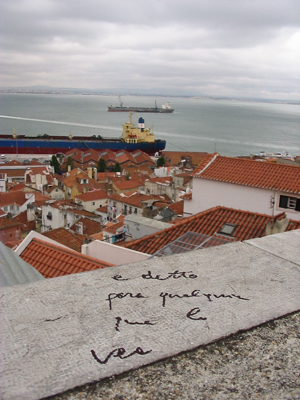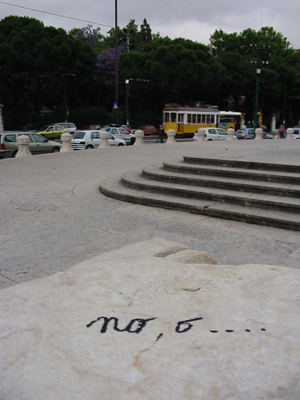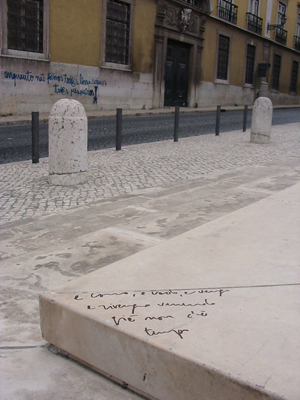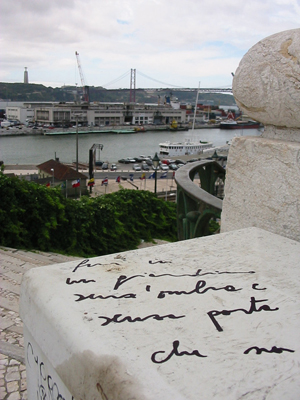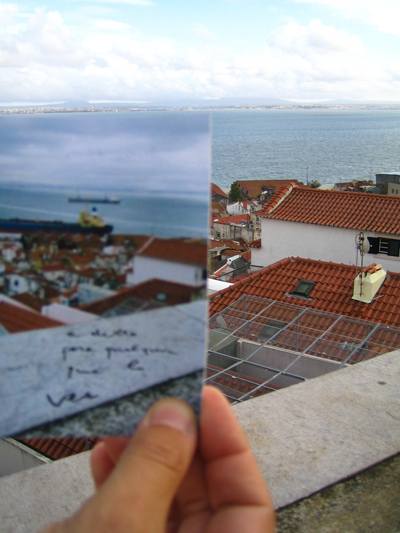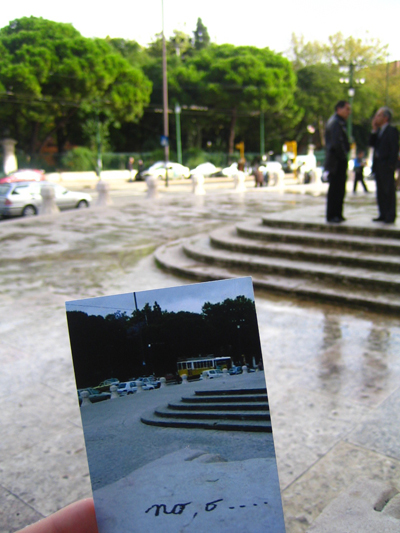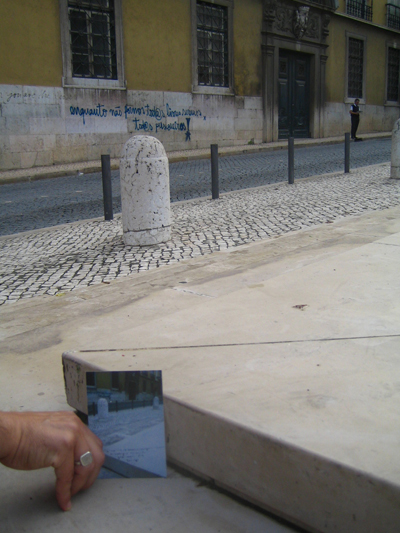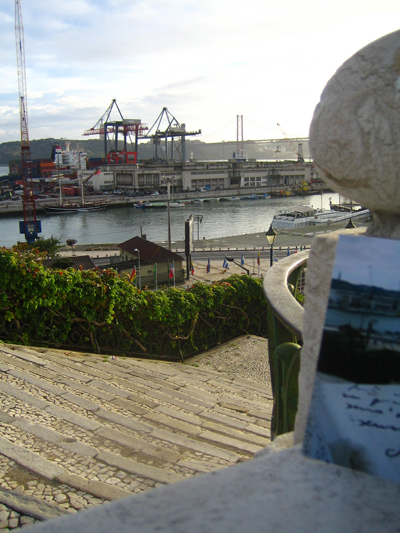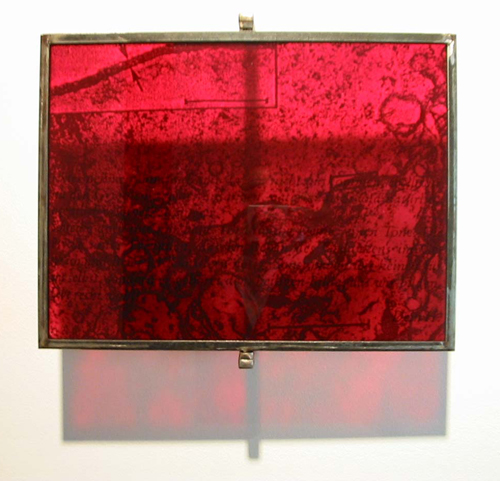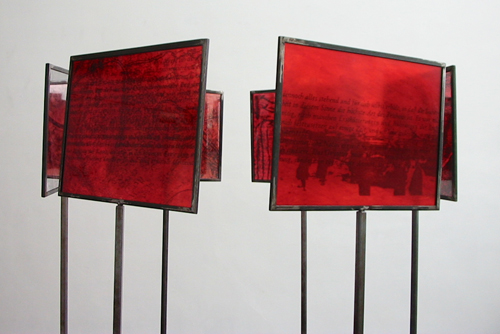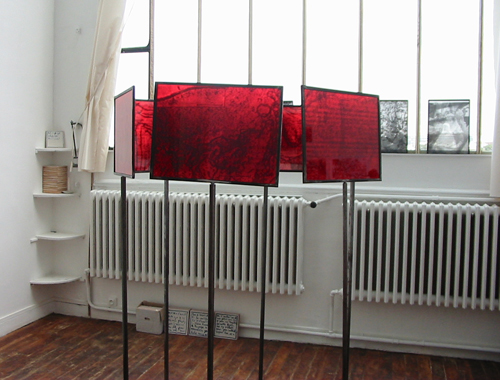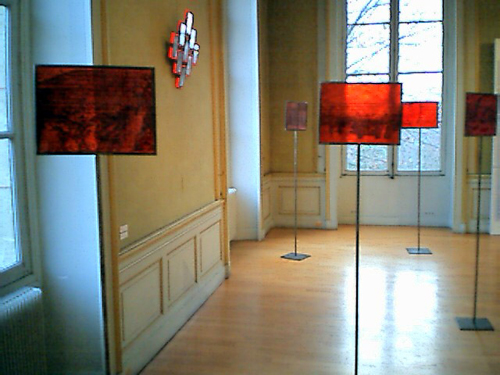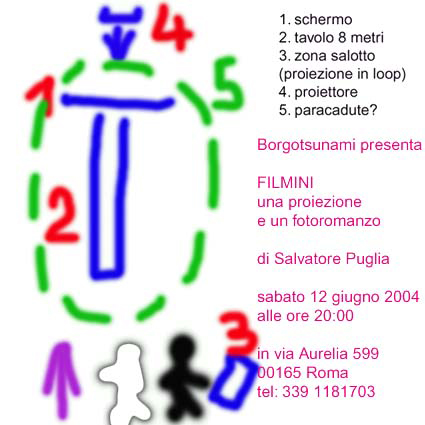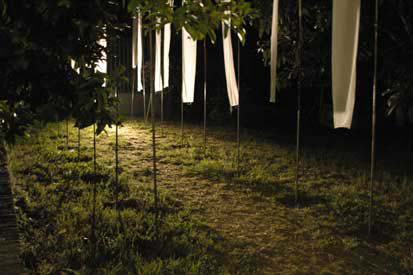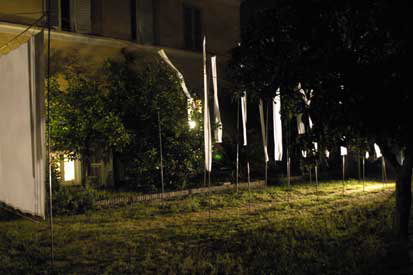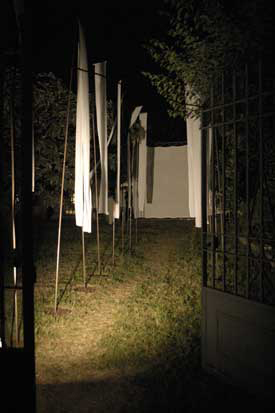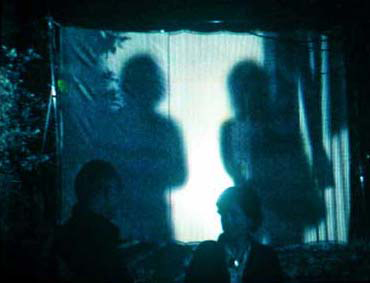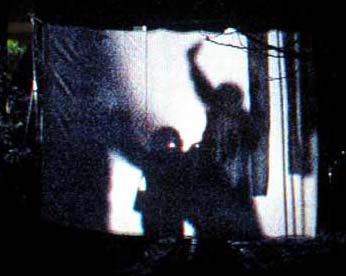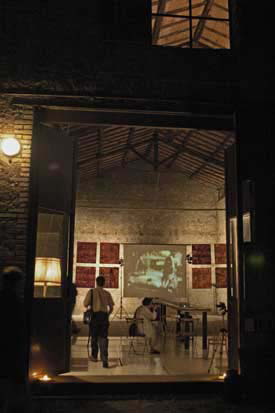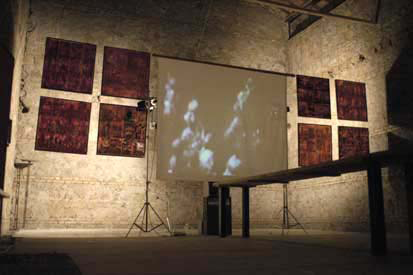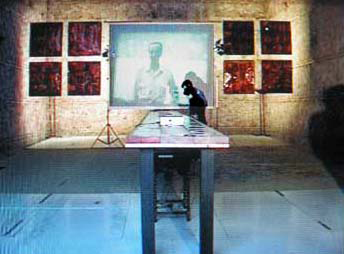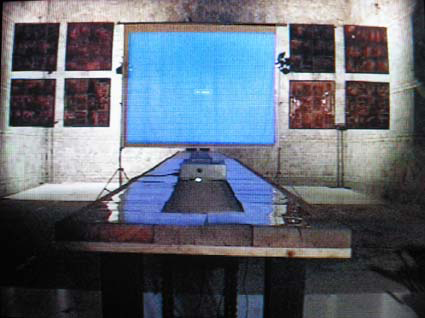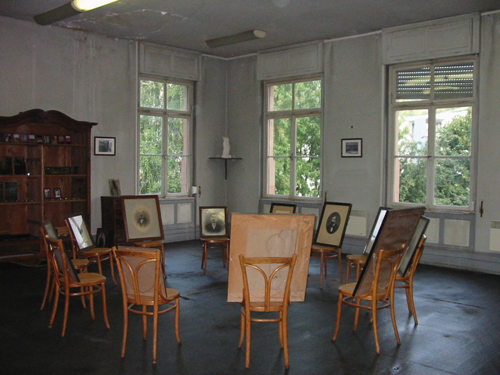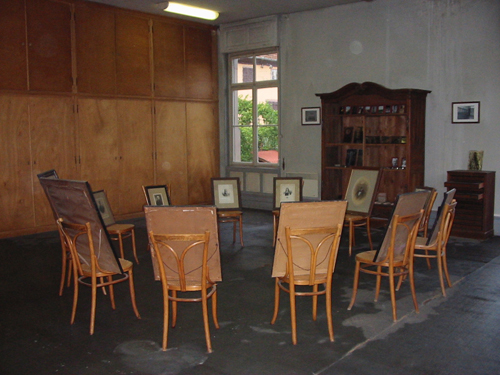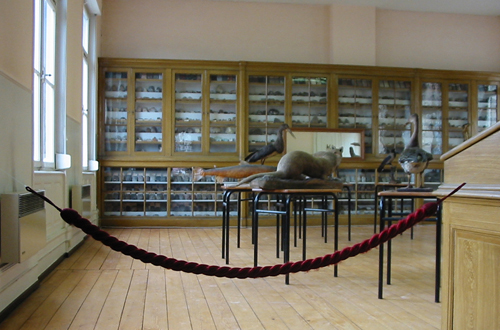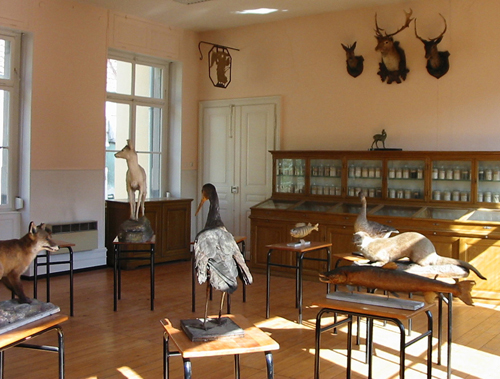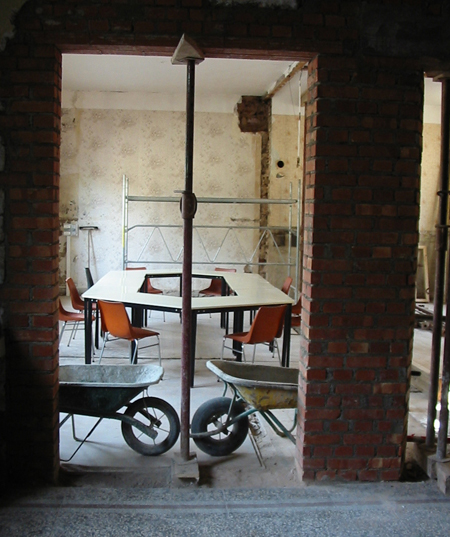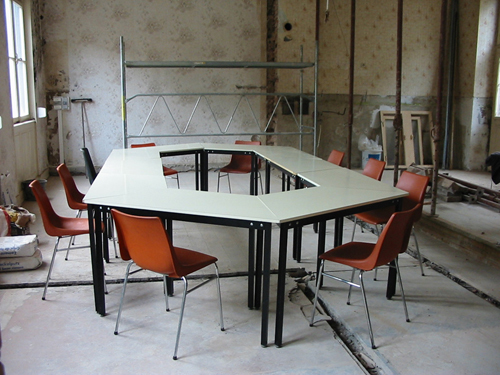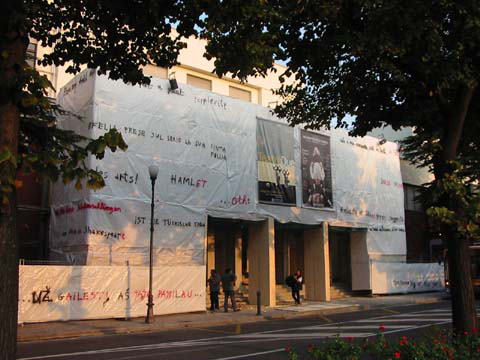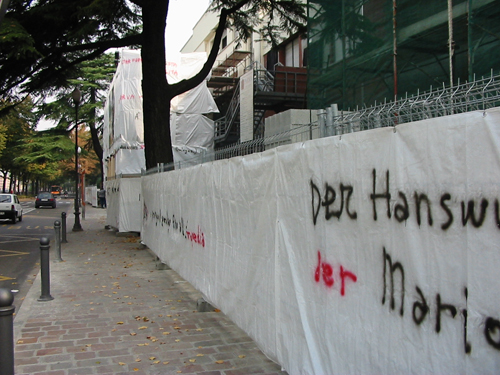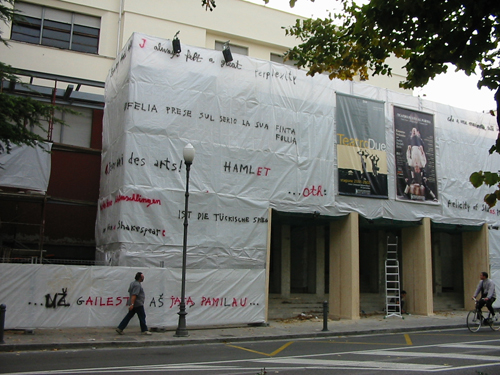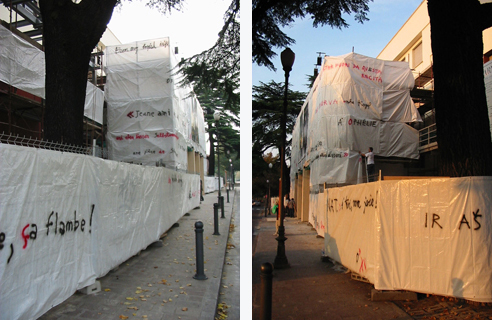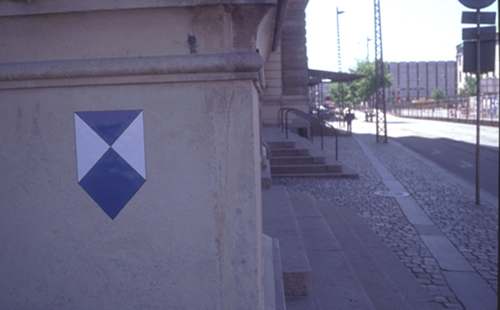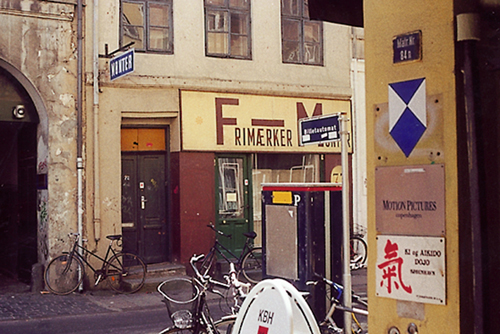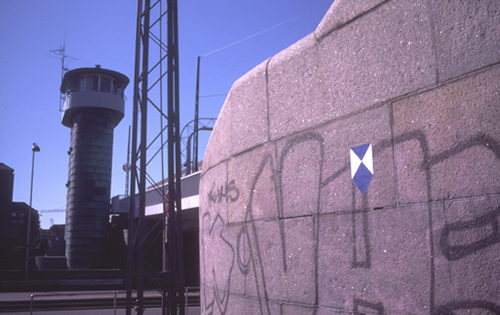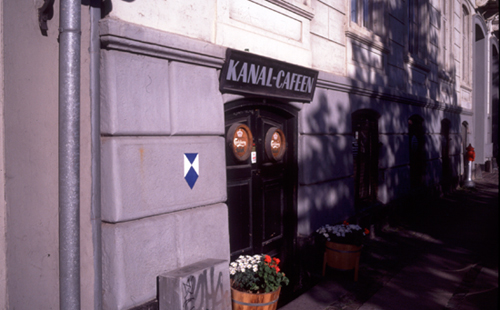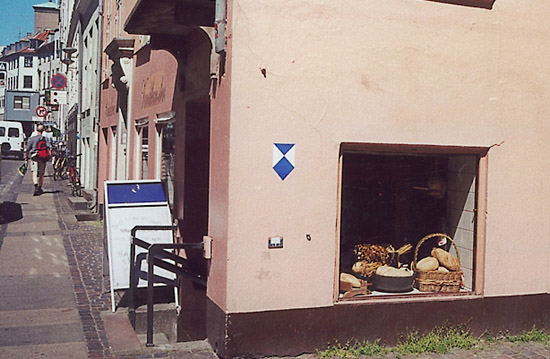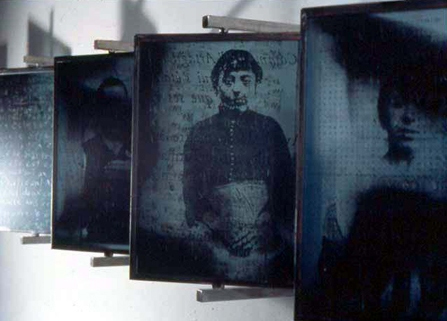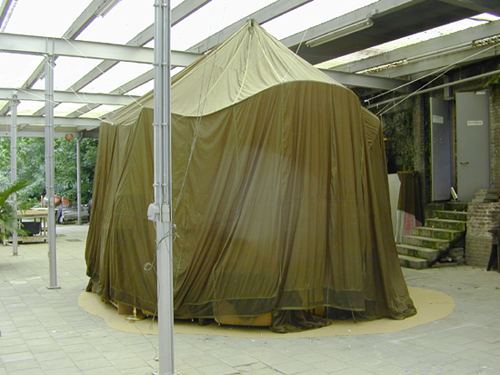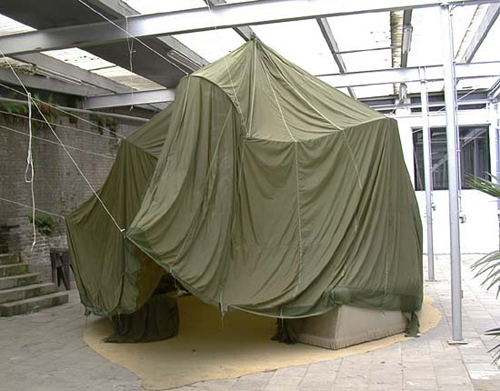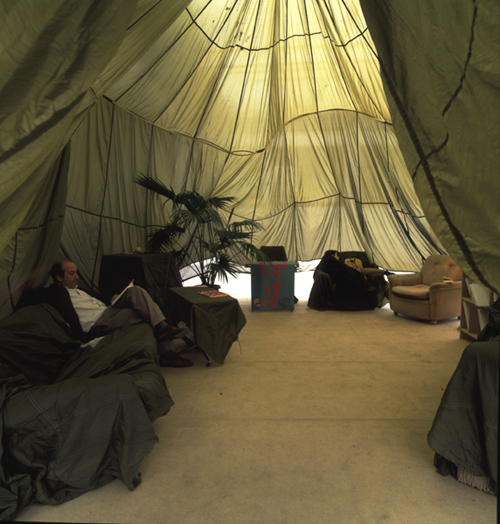The brief text that follows should be read in conjunction with the images of two works, one of which has been made (The Blue Shield, also titled Personal Monuments) and one that has been imagined but never realized (The Lifetube).
It should be taken, rather than simply a comment, as an allegorical writing referring to my activity at the Jan Van Eyck Academie and related places during the last year. This activity has been moving around the concepts of translation and transparency, their multiple relations, and the image of the artist as a translator.
I
The Blue Shield
(displaced symbols)
The language of symbols should be understood by everybody—it is assumed by the illiterate as well as the one who speaks a foreign language. This is why road signals and naval ones have been invented, along with symbolic tools, among which I am most interested in the ones that indicate the individuals or the objects that, following international conventions, should consider themselves protected.
This is the case with the Red Cross, that is universally recognized as the symbol under whose protection find place field hospitals, ambulances, stretchers, doctors and nurses.
It is a given that such places and individuals should not be involved in war—since we are supposed to have a shared respect for the wounded and to their possibility of care and recovery.
Since 1954, an analogous symbol exists for artistic monuments and the cultural patrimony in general: the Blue Shield. In 1954, a list of sites to be protected was compiled at the Hague Convention, and then improved in a second protocol in May 1999. Such a list also comprehends, beyond works of art, libraries, archives, churches, and mosques.
The most famous example of a cultural site protected by UNESCO is the old city of Dubrovnik, which was copiously bombed by the Serbs during the war in ex-Yugoslavia. It is said that Serbs were particularly interested in destroying the cultural symbols of their adversaries; on the other hand, it is also said that the Croatian army sheltered its weapons and ammunitions in the sites marked by the Blue Shield.
Consequently, the 1999 protocol corrected that of 1954, establishing the conditions under which “imperative military necessities” could justify attacks against cultural sites, regulating the behaviour of the occupying troops, and foreseeing extradition for the most serious crimes committed against the monuments.
.
The issue of the protection of monuments has always interested me. I have wanted to study the way in which, during moments of fascism (and, to be sure, under every regime that makes monuments into the icons of nationality) historical monuments are taken out of their urban context, polished up from every successive side, and made integrally visible, –since, according to Mussolini, they were meant to “gigantify in their necessary solitude.”
As we know, the war came and with it the necessity of hiding monuments from view and from the risks of bombing; they were hidden under scaffoldings, concrete and brick walls, sand bags and stuffed mattresses. For five years, from 1940 to 1945, the Italian landscape was disseminated with such mysterious and incongruous forms; the art was there, but not to be seen.
From this point of view, the 1954 Hague Convention has led to significant progress: instead of sandbags—after all, a poor means of protecting monuments from modern armaments—a simple shield painted in white and blue.
. . . . . . . . . .
In May 2000, I was in Copenhagen, the capital of one of those northern nations in which protection is a kind of ideology; social protection, the protection of infancy, of the natural environment, of young artists. The protective role of the State there appears like the realization of the socialist ideals of the beginning of the Century, but can be so overwhelming that some artists—maybe because of their own dependence on their relationship with the institutions—wonder how such a system could be resisted (whereas in a country like Italy, where family networks and good relations occupy the role that, in the northern countries, belongs to the State, the more valid forms of resistance are—to my mind—the ones that are practised inside institutions, because those are the places of chaos).
But, as I was saying, I was in Copenhagen, having been invited to participate in a show on the theme: Models of resistance.
To put in practice my solidarity and participation I took part in the setting up of the show, transporting heavy glass plates and painting the walls of the stands. But, more than simply a labourer, which I am not, I found myself more useful –like the Italian that I am—as a cook. It was more useful for the real workers to be fed properly and to abdicate, at least for a couple of days, their frankfurters in favour of a good hot dish.
However, before the show opened, I also wanted to do my part for art. I had already spent a short period in Copenhagen five years earlier; I had lived there a brief and intense personal story. Therefore, I reproduced on adhesive plastics the symbol of the aforementioned UNESCO program, the Blue Shield, and one morning at dawn I went out, in the still deserted city, in search of the places where I had lived some events. Among these places were the Royal Theatre Opera, an antiquarian bookstore, a coffee shop, a hot-dog kiosk, a bridge, a filthy hotel. I applied twelve of these symbols on the façades or walls of these personal “places of memory.”
Once I had compiled an inventory of such work of marking and accompanied it with adequate photographic documentation, I showed it at the Overgaden gallery. A copy of the dossier, with an enclosed letter, was sent to Icomos, the international organization based in Paris that manages the Blue Shield program.
In this letter I explained how, believing that historical memory is made of an endless sum of individual knowledges and memories, I wished to add to this sum at least a part of mine, and I asked, correctly, I believe, that my memories be considered a cultural patrimony of humanity and—in case of war or any other natural catastrophe—would be protected by the Hague Convention.
I also asked about the question of “hierarchisation” in the concept of cultural heritage. Why, I asked, should the medieval cathedral be protected more than the Souvenir Shop that stands in front of it? Why, if it is true that the Souvenir Shop could not exist without the cathedral, should it be true that the cathedral would survive without its postcards? Not longing for a critical-philosophical discussion, I did not dwell further (but I would have been able to) on the matters of the original and the copy, of real art and kitsch, or popular and elite culture, et cetera.
I did not receive any answer from Icomos. On the contrary, the inhabitants of Copenhagen seem to have been more understanding. Of the twelve symbols placed alongside my personal monuments, only a few of them have been removed. It happened also that one of them was displaced and put again at a little distance, because the wall on which it stayed had to be repainted. My supposition is that they have taken the symbol for a sign of the gas pipeline, which would demonstrate the imperfection of the international system of signs.
But it would demonstrate also the creative side of the misunderstanding. In a system of signalisation—like this one experimented in the Danish capital—one that is neither logical nor systematic, the symbol is presented as a sign, but it is not the evidence of its possible prolongation: it does not have a recognizable relationship with the symbolized object, it does not indicate anything reducible to an original and reconstructible path. It rather points out an autonomous track, with, if one wishes, references to be interpreted, or, if one prefers, just read.
This would be a form of displaced translation. Such a translation is permitted by an originary vulnerability of its subject. Generally speaking, translation is permitted by an originary transparency that carries in itself its own possibilities of translation.
Transparency goes only to one direction. One cannot make transparent something that originally is opaque, but one can multiply and open further a transparency which is already in the original object.
Transparency is perhaps the first quality of a work of art; such a work is a work of translation. If the kitsch (like we will see further on) -in its lack of distance from its object- only allows a movement between A and B and back from B to A and so on, transparency is what allows to translation its successive passages from A to B and from B to C and so on.
Such a movement of passage is doomed -clearly- to be interrupted somewhere. In the following chapter I will try to explain how one cannot give a supplementary transparency to something that has already undergone a radical transformation.
II
The Lifetube
(displaced people)
During the entirety of the summer of 2000, as it had happened for all of 1999, thousands of illegal immigrants continued to disembark on the Italian coasts. They came mainly from the Albanian harbours, just a few hours of navigation away. They came in large inflatable boats driven by cynical sailors, who did not hesitate to throw their human load off board, if they felt sighted or pursued by the Italian coast guard.
The image of these boats and rafts could be seen everyday in the television news. Maybe these images inspired a new attitude of the demonstrators against the detention centres where the illegal immigrants were kept. Beginning in January 2000, the policemen found themselves facing crowds that demonstrated before such centres, clamouring for them to be closed down, and whose components were dressed in the following way: three or four layers of heavy sweaters, life vests, foam stuffings fixed to the shoulders with package ribbon, football pads to protect the legs, plastic helmets or pasta drippers to protect the head. Besides, the first lines of the demonstrators pushed a strange supply before them: a kind of big snake made of truck tubes bent together two by two, packed in plastic sheets and fixed to polystyrene panels, against which the clubs and the tear gas candles bounced. The name of the utensil emerged almost spontaneously: the Big Rubber (Il Gommone). (1)
Many demonstrators advanced toward the police with their arms lifted in a sign of peace. “Nobody must get hurt” was their intention. They cried out for both the right to occupy the public space and to protect themselves. They did not manifest violence, but they opposed to the violence a claim of legitimate defence.
They wore, to the letter, a life belt; the supply meant to save the life of whoever would fall into the sea became at the same time a symbolic image and tool of defence. With this simple opposition of the body, protected by an individual and a collective stuffing, the right of resistance was identified with the right to existence.
I find that this invention has a great iconic strength: an elastic matter, a rubber wall on which the kicks of the rifle can bounce and behind which bodies take refuge.
In those first occasions, the police, unprepared for this new tactic, gave up and the demonstrators, after many hours of confrontation, were admitted inside the centres of detention which they wanted to see close (namely: Milan, January 29). It is no surprise that, for the following demonstration, the police officers arrived armed with cutters.
What I will say here is perhaps a banality: a protection understood as “resistance” goes along with a recognition of brittleness and inadequacy. A total and absolute protection is not only impossible but would coincide with the suffocation of the same resistance and of its dialectics. An allegorical side is always necessary to the action of resistance, to keep such an action from both an undesirable literacy and the affirmation of a dull antagonism.
The use of the big truck tubes by the demonstrators was born by a significant image and bore a semantic shift: the device that transports the clandestine immigration becomes the symbol (and the defence tool) of whoever works against the understanding of this immigration as a crime (it should be said as well that, on an institutional level, the Italian detention centres are illegal, since immigration is not a crime contemplated by the penal code).
I think that the Big Rubber is both an art’s work and a work of art. I see such qualities not just in its practice of re-appropriation, but also in its affirmation of autonomy and of a kind of disinvestment toward its source.
If I instead lingered on the idea of making art out of the Big Rubber (or, as well, out of the immigrants’ inflatable boats), I would seriously risk falling into kitsch. My work would probably just remain a description, an allusion or an illustration. And kitsch always remains interested, involved; it always stays subordinate to its model: to the call to an original function, if it is an object; or to the intention, if it intends to be a work of art. When the intention remains translucent in the work, then the work fails. When the original is so determined in its significance, it should be left to itself.
If I would make art out of the image of this “life tube”, I would apply what, according to Gillo Dorfles (2), is the distinctive sign of the kitsch mentality, and that is the simple shift, in scale or of context, of the original work (for instance: the Eiffel tower transformed into a knickknack and standing on a television set; a Roman amphora used as a lamp; but also, I would add, the effect of an easy association: the sticker, with the name of a restaurant that casually is that of a friend, that we leave on his fridge). It is certain that -in a way or in the other- kitsch, in its work of de-contextualisation and transformation, has to do with mechanical or digital reproduction.
Does it, then, also have to do with translation? Partly, and up to a certain point. My attempt to make a work of art out of the Big Rubber would be an attempt of translation, a movement toward translation, but not a finished translation. Mine would be just an illustration, because it would not create any semantic estrangement. If it did not practise a deep alteration of the original language itself and if, together with the estrangement, it did not introduce a radical difference, the translation would be the supreme form of kitsch. (3)
It remains, however, the awareness of a contiguity between translation and kitsch. In other words: in its dependence on an original (however real or ideal that would be), in its quality of prolongation (with all the inevitable denaturalisations and misunderstandings), in its inevitable imitative character, and also in its certain monstrous character, kitsch appears like an aborted form of translation. That we practise it all day long, in a more or less wide measure and in a more or less aware way, only confirms its multi- and incomplete- form of the translation.
While kitsch represents, translation re-presents; this is why the Big Rubber is both a translation and a work of art. The forms of the translation are multiple, and they sometimes take the quality of art. This happens when, of a subject already alienated, already displaced and stolen from its world, already “kitschified”, a subject is created again—as autonomous, as a “pure sign of itself” (Jean-Luc Nancy, Corpus). The loss of an acquired originality becomes, in this translation, an other originality, an other possible. This “resumption” would be the displacement of a displacement, the unveiling of a hidden originality that does not have to wait the de-kitschifying effect of the time that passes or of historical catastrophes.
I think of an other possible rescue of kitsch, one that comes from its very historical de-contextualisation; this is the case of some works that remain as testimonies of an ancient art: those that probably were provincial and imitative episodes, which a contemporary critic would have certainly considered “kitsch,” like the mural paintings of Pompei or the funeral portraits of El Fayum, and which are seen by us as mere works of art (4). The action of time has conferred on them a singularity that they did not possess and a quality that has become absolute.
It is the time that—in these cases—operates the semantic transformation of an object that becomes, according to a worn-out expression, “other from itself”; that becomes therefore projected into the world of difference, the same world that kitsch tends to ignore.
It would be difficult to deny that first postmodernism in architecture and then the artistic practices of the Eighties have led to a conceptual revaluation of kitsch, and precisely in those aspects that, in the years around World War II, were still considered to be at the best expression of aesthetic insensibility (see: Clement Greenberg, “Avant-Garde and Kitsch,” written in 1939) and at the worst of ethical evil (Hermann Broch, “Notes on the problem of kitsch,” lecture delivered at Yale university in 1950): the inspiration, the impression, the imitation, the reproduction, the call to the tradition.
And if there is a “sin” of kitsch, it is precisely that of supposing that a tradition exists, that there are references and models to be faithful to, that forms are endlessly multipliable, that there is a possibility of aesthetic reassurance and emotional protection.
Kitsch, which in his substitutive practice represents a continuous affirmation of loss, never lingers in mourning; even less does it mourn what is stranger. Inside it, apparently, there is space only for the familiar and the identifiable.
To mourn the stranger, to regret the one whom we will never meet, this is the opposite of kitsch: it means to perform an act of recognition and to go beyond the recognition, to perform an act of memory and to go beyond the memory, to depart from the tradition without adopting a borrowed one, to remain in the kingdom of the possible.
From the other “sin” of kitsch, the one stigmatised by Broch and recalled in the Eighties by authors like Lyotard and Vattimo (5) -that is, the tension toward the beautiful- contemporary art has somehow saved us. To tell to an artist that his work is beautiful is today a way of insulting him. And the reason for this is the fact that today’s art does not intend to make “work” but, rather, “to make world” (6).
And here is where the Big Rubber returns, and the fact that it is a matter of art, an “art’s work”. This status is given to it precisely by the abdication of the art to its iconicity and to its uniqueness. Art is not a gesture, but rather a repeated gesture. And the repetition, as Aristotle once said, “gives birth to a nature.”
(1) For an accurate description of this demonstrative tool see: Ludovic Prieur, Brigitte Tijou, ”Il Gommone. Un dispositif de désobéissance civile”, Vacarme, n. 12,
(2) See his introduction to: Kitsch. An Anthology of Bad Taste, New York, 1969.
(3) “The translator is a writer of a rare singularity, precisely where he seems not to claim any. He is the secret master of the difference of languages, not to abolish it, but to use it…” Maurice Blanchot “Sulla traduzione”, Aut Aut, n. 189-190, Milano 1982, pp. 98-101 (Originally: “Reprises”, Nouvelle Revue Française, n. 93, Paris 1960).
(4) I find this example in Hermann Broch, “Das Böse im Wertsystem der Kunst”, Schriften zur Literatur, vol. II, Frankfurt am Main 1975 (first published in Die Neue Rundschau, August 1933), p. 155.
(5) “.. that to make beautiful art today is to make kitsch; that even authenticity is precluded… “, Jean-François Lyotard, Heidegger and “the jews”, Minneapolis-London 1997 (Paris 1988), p. 45.
(6) See Gianni Vattimo, “L’impossible oubli”, in Usages de l’oubli, Paris 1988, pp. 77-89.
